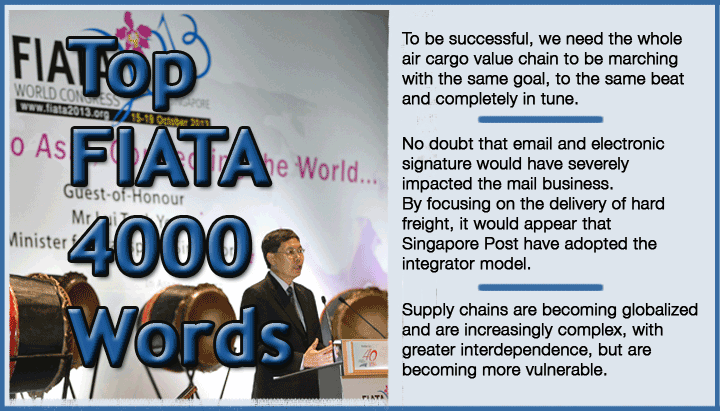
 f there is one area in which FIATA seems
head and shoulders above other global transportation events, it is in
the quality of the sessions and speakers gathered at their annual conference.
f there is one area in which FIATA seems
head and shoulders above other global transportation events, it is in
the quality of the sessions and speakers gathered at their annual conference.
This year’s Singapore opus was no exception.
The planners at this conference picked a brilliant logistics city
for their event. They also took the time and trouble to think about what
they wanted to say to their membership, and lined up a stellar cast of
characters to deliver the message.
Out of the gate, we would give FIATA Sessions
an 8+ (out of 10) for session content.
Overall and on balance, FIATA 2013 was an
interesting conference.
It is important that while our industry
still faces turbulent waters, important issues continue to be tabled and
recommendations as to how to proceed are shared.
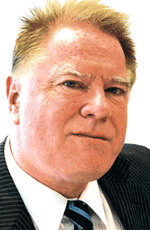 FlyingTypers
has presented several stories about FIATA Singapore 2013 (see FIATA Scope
below), but we think this last one to which we devote our entire issue
is needed and can be useful in pondering some of the issues confronting
air cargo. FlyingTypers
has presented several stories about FIATA Singapore 2013 (see FIATA Scope
below), but we think this last one to which we devote our entire issue
is needed and can be useful in pondering some of the issues confronting
air cargo.
You walk away from this city–state
encounter thinking that there are a lot of smart people in Singapore,
and this conference spotlighted a caravan of good and constructive thought.
So we tell our stories, here highlighting
some comments and sessions at FIATA 2013.
Air Cargo’s “IT Sage”
and one of the smartest, nicest people we have met is Patrick Murray,
Head of Dubai-based CALOGI.
Patrick likes big conferences and he is
good at them, and his presence is good for them as well.
Patrick manages to mix total knowledge and
plain speaking with a bit of fun, so everyone gets a lift.
For an example, look no further than all
the ipads that were awarded at the CALOGI booth for winning at a game
that has become a Singapore obsession: throwing darts.
But beyond the fun and games, Patrick puts
his own special spin on what he heard and thought at FIATA.
The sessions are in no particular order,
and this discussion is by no means all that went on at FIATA Singapore,
with apologies to those who were edited for space.
In any case, at nearly four thousand words,
best to press the “save button” here and digest this story
slowly or find a quiet place to curl up with your laptop or other device
to take all this in.
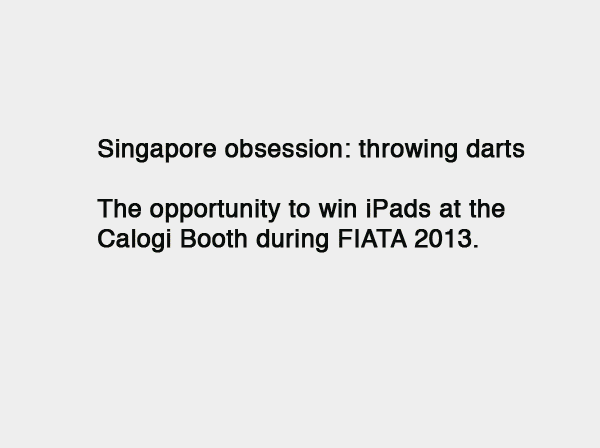 |

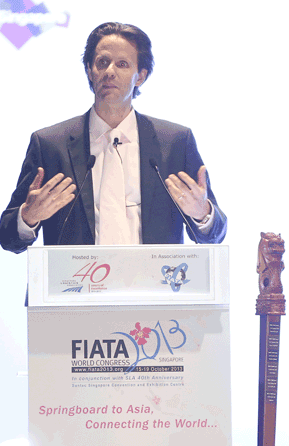 As
our industry continues to talk about innovation, Dr. Wolfgang Baier, Group
Chief Executive Officer, Singapore Post Limited, shared some innovative
insights during his session presentation, ‘Internationalization
Strategies from Singapore Post's Perspective’. As
our industry continues to talk about innovation, Dr. Wolfgang Baier, Group
Chief Executive Officer, Singapore Post Limited, shared some innovative
insights during his session presentation, ‘Internationalization
Strategies from Singapore Post's Perspective’.
As part of his introduction, Dr. Baer posed
a question, and upon hearing it, it made us smile:
“Is he at the right conference?”
he asked, and justified his presence by explaining that, unbeknownst to
many, Singapore Post (SingPost) is one of the top 3 Singapore based freight
forwarders.
We learned that the company has a history
of 150 years serving Singapore, with 2.5B$ of market capitalization and
a footprint in 12 countries. SingPost delivers 3 million items each business
day and has over 4,700 employees.
The current challenges faced by SingPost
include: declining mail volumes; escalating operating costs; strict regulations;
liberalized markets; and high service expectations. Despite this, a key
objective had been how to continue to grow the Singapore hub.
The solution was to combine the opportunities
offered by Singapore and e-commerce to provide a winning combination.
The resulting strategy will protect the
core business, such as mail and digital services, while growing the wings
in developing logistics/fulfillment, e-commerce, and retail services.
Singapore Post’s e-commerce logistics
is built on 4 pillars: Transportation, Warehousing and fulfillment, Last
Mile Delivery/Returns and Marketing Criteria Management, and Payments.
Diversity is a key driver. SingPost is able
to meet the special demands of the chemical and fine arts industry, allows
web-enabled track and trace, has convenience store touch points, and runs
the e-commerce business for Adidas in South East Asia.
Finally, on the subject of e-commerce, Dr.
Baer cited that global e-commerce transactions were worth 1.1 trillion
dollars in 2012, growing to 1.9 trillion dollars by 2016. In 2020 the
Asia Pacific Region will outstrip U.S. and EU e-commerce transactions
by 1 trillion dollars. SingPost is positioning the company to capitalize
on this growth.
“Great to see how other companies
in the logistics sector are addressing challenges of decline in traditional
industries,” Patrick Murray said.
“No doubt that email and electronic
signature would have severely impacted the mail business.
“By focusing on the delivery of hard
freight, it would appear that Singapore Post have adopted the integrator
model.
“One only has to look at their website
to see how they have diversified their business.
“Firstly SingPost collect, sort and
distribute domestic and international mail offering service quality according
to standards set by Infocomm Development Authority of Singapore (IDA).
SingPost provide delivery solutions domestically and internationally,
with their own door-to-door courier brand to address the needs of corporate
and retail customers.
“Additionally, they also offer integrated,
customized logistics solutions that cover a wide range of value-added
services including warehousing, fulfillment, distribution, and inventory
management.
“SingPost also own one of the largest
retail distribution networks in Singapore.
“Their internet portal provides customers
with a wide variety of postal, bill payment, ticketing, government application,
and payment options as well as financial services.
“SingPost are always looking for opportunities
and are not constrained by staying in their comfort zone.
“No doubt the above represents a complex
business model and by Dr. Baers’s own admission sometimes it is
two steps forward and one step back, but the company is committed to innovation,
and transformation is part of the corporate culture.
“From my own experience, I can sympathize
with SingPost in that innovation comes at a cost and sometimes re-work
is required.
“This is a price that is worth paying,”
Patrick concluded.

There were also presentations relating to
Authorized Economic Operator Programs and Mutual Recognition Arrangements
that were outstanding at FIATA.
 Mr.
Teck Leong LIM, Deputy Director-General (Compliance and Facilitation)
Singapore Customs shared his thoughts when presenting ‘AEO Programs
and MRAs (Mutual Recognition Assignments): International Developments
and Singapore's Perspective.’ Mr.
Teck Leong LIM, Deputy Director-General (Compliance and Facilitation)
Singapore Customs shared his thoughts when presenting ‘AEO Programs
and MRAs (Mutual Recognition Assignments): International Developments
and Singapore's Perspective.’
Mr. Teck Leong reminded the audience that
supply chains are becoming globalized and are increasingly complex, with
greater interdependence, but are becoming more vulnerable.
The Global Customs response to this is the
SAFE Framework of Standards that, amongst other things, includes the following
objectives:
1. Establish
standards that provide supply chain security and facilitation at a global
level to promote certainty and predictability.
2. Strengthen
Customs/Business co-operation.
3. Promote
the seamless movement of goods through secure international trade supply
chains.
One of the key elements of the framework
is the ‘Authorized Economic Operator’ (AEO), the definition
of which is as follows:
“A
party involved in the international movement of goods in whatever function
that has been approved by or on behalf of a national Customs administration
as complying with WCO or equivalent supply chain security standards.
“Authorized
Economic Operators include inter alia manufacturers, importers, exporters,
brokers, carriers, consolidators, intermediaries, ports, airports, terminal
operators, integrated operators, warehouses and distributors."
Mr. Leong mentioned that a successful AEO
program must meet the national criteria, but will need to be designed
to satisfy the requirements for MRA; however, MRAs also require trust
between the various Customs administrations.
The advantages of MRAs are that they will
strengthen the global supply chain.
Launched in 2007, Singapore's AEO program
is the Secure Trade Partnership (STP).
The STP is a voluntary certification program
that encourages companies to adopt robust security measures in their trading
operations, and to play their part in enhancing the security of the global
supply chain.
Open to all supply chain stakeholders such
as importers, exporters, warehouse operators, transporters, and terminal
operators among others, the program guides companies in the development,
implementation, monitoring, and review of their supply chain security
measures and practices.
Singapore Customs take the view that every
node is responsible for the security of the shipment.
Aside from establishing the necessary domestic
framework to enhance supply chain security within Singapore, the STP allows
Singapore to engage important trading partners with compatible AEO programs
through MRAs.
For this purpose, a higher level of accreditation
known as the STPPlus is used to align the program with international standards.
While each country is unique, it is essential
to recognize and agree the common objective is to enhance the security
of the supply chain.
Currently Singapore mutually recognizes,
AEO programs in Canada, Korea, Japan and China.
For businesses certified under their country's
AEO program, their exports would be recognized by the other country's
customs authority as being of lower risk, thus making them less liable
for inspection and allowing their expedited release at the point of importation.
Mr. Teck Leong concluded with the following
points when developing an AEO program:
1. Keep in
mind total supply chain security.
2. Expand
AEOs and expand the web of MRAs.
3. Everyone
has their part to play in securing the supply chain.
 Prof. David Widdowson, Director and Chief Executive Officer - Centre for
Customs & Excise Studies, University of Canberra, Australia, shared
his thoughts during his presentation, ‘Impact of the Authorized
Economic Operator Concept and its Derivatives in the Context of Mutual
Recognition.’
Prof. David Widdowson, Director and Chief Executive Officer - Centre for
Customs & Excise Studies, University of Canberra, Australia, shared
his thoughts during his presentation, ‘Impact of the Authorized
Economic Operator Concept and its Derivatives in the Context of Mutual
Recognition.’
Prof. Widdowson opened by explaining that
partnership programs traditionally focused on trader’s general compliance
with Customs requirements.
However, security initiatives have introduced
an additional concept of partnership.
A compliant trader historically would be
one achieving a level of compliance with regulatory requirements.
An AEO covers compliance with the SAFE criteria
to secure and facilitate trade.
The supply chain is only secure as its weakest
link and in some countries the weakest link is Customs.
For instance, certain traders have found
that they have to satisfy the requirements of an AEO and ACO (Authorized
Customs Operator).
Traders are reluctant to become known shippers
or regulated agents due to the cost, although eventually the industry
must move in this direction.
To encourage traders to join AEO programs,
the benefits to being an AEO need to be tangible, including:
1. Reduced
documentary requirements.
2. Priority
inspection.
3. Reduction
in fees and charges.
4. Expedited
process to resolve queries.
Prof. Widdowson continued by explaining
that in 2005, the original SAFE framework focused on security, whereas
later enhancements included the facilitation of trade.
However, there is global inconsistency in
that some customs authorities are focusing on security while others have
interpreted SAFE to include trade compliance and revenue risk.
Meanwhile, mutual recognition is key and
the impact can be severe in that delays and costs incurred if the exporter
is not recognized by Customs in the destination country.
Furthermore another fundamental change is
that the SAFE definition of high risk cargo is ‘that for which there
is inadequate information or reason to deem it as low risk, that tactical
intelligence indicates as high risk, or that a risk-scoring assessment
methodology based on security-related data elements identifies as high
risk.’
Previously, all cargo had been identified
as low risk unless Customs determine otherwise.
Now it is high risk unless proven otherwise.
In terms of risk assessment, there are three
scenarios that the industry needs to deal with:
1. Unknown
shipper and forwarder – GHA responsible for security.
2. Unknown
Shipper and regulated agent – Forwarder responsible for security.
3. Known shipper
and regulated agent - Shipper responsible for security.
A secure supply chain can still be achieved
by ensuring the goods are exported by an AEO, and this is an opportunity
for freight forwarders.
There also needs to be internal cross agency
recognition and there can be domestic overlaps, such as:
1. Agriculture
– Accredited Food Exporter
2. Transport
Security – Known shipper
3. Customs
– AEO
Prof. Widdowson closed with two points.
Firstly, the Mutual Recognition of programs in that the process relies
on bilateral agreements between countries and multilateral solutions are
not really being pursued.
This means that 11,476 MRAs will be required.
He recommended that WCO, APEC, CAPEC, and
other international organizations should develop and agree solutions that
cover their member countries, thus considerably reducing the number of
MRAs.
Finally, he offered the following observations:
1. The benefits
result in faster clearance and release in destination countries.
2. MRAs must
play a major role in trade negotiations.
3. Regional
agreements must supersede bilateral agreements.
4. Inter-agency
collaboration is essential and governments need to play their part.

“I remember the SAFE framework of standards,”
Patrick Murray told FlyingTypers.
“The concept of the AEO is from my
earlier days at IATA and it’s good to see that over the years it
is taking shape and the definitions and the positive impact are starting
to become much clearer.
“Prof Widddowson made sense in terms
of his summing up and the way forward.
“Benefits to the trader of a well
thought-out program are there to be had.
“It remains to be seen how quickly
the program moves ahead.
“Tying this program in with e-freight
(reduced documentation) also seems logical.”

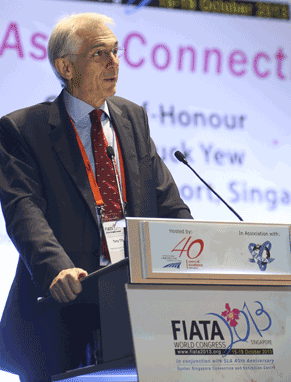 On day 2, Tony Tyler, Director-General & CEO of the International
Air Transportation Association, took the stand and talked about ‘Delivering
Solutions Together.’
On day 2, Tony Tyler, Director-General & CEO of the International
Air Transportation Association, took the stand and talked about ‘Delivering
Solutions Together.’
Mr. Tyler pointed out that it had been over
a decade since an IATA Director General addressed this Federation, although
the organizations work very closely together and are partners in global
air freight.
Mr. Tyler went on to say that, “historically,
the air cargo business has grown by 5-6 percent annually, thus the expectation
has been set that this rate would continue as world trade grows. But the
aftermath of the global financial crisis is now challenging that assumption.
Cargo volumes plummeted in 2009 and bounced back strongly in 2010. That
was as expected.
“But then the growth stopped and air
cargo has since stagnated.
“The reality is that since 2010, world
trade has grown by 12 percent, but air cargo volumes have only grown by
2 percent, meaning other transport modes, such as maritime transport,
are growing more quickly than air cargo.
“Integrators are bucking the trend
with solid growth. Furthermore, revenues are shrinking.
“In 2010, air cargo accounted for
$66 billion in revenue. This year revenues of just $59 billion are expected.
“Four years ago air cargo was 11.4
percent of airline revenues. This year it will be 8.3 percent.
“Passenger demand remains robust,
but every wide-body introduced or upgraded to meet passenger demand has
belly space for cargo.
“It’s hard to see yields improving
any time soon.”
Mr. Tyler also gave examples of how patterns
of development, innovation, and business intelligence have eroded much
of the value that shippers see in speed. One example focused on ships
being equipped and delivered with highly sophisticated temperature control
and lighting systems.
“Fresh fruit, for example, is being
picked earlier and loaded on ships.
“The products ripen on board where
they can be processed, bagged, and labeled so that they are ready for
immediate distribution on arrival. No need for warehouse or distribution
premises on land—the entire process can be done in transit. Result:
time and money saved.”
While the outlook is far from rosy, Mr.
Tyler gave examples as to how forwarders and airlines can work in partnership
to build a stronger future for air cargo.

Des Vertannes and his team will work with
FIATA and the Global Air Cargo Advisory Group (GACAG) to enhance the C2K
master operating plan, service promises of the industry to its shippers
can be measured. The process is set to be demonstrable by the end of 2014.
Implement e-air waybill (e-AWB) and e-freight
This is a familiar theme.
Tyler said, “customers expect instantaneous
access to accurate information, and already receive it today from the
integrators. This played a large part of the inspiration for e-freight.
We started the vision in 2004. "Nearly
10 years later, progress has been disappointing. Penetration of e-AWB
as an initial step is still at just 9 percent, not even half the 2013
target that the airline CEOs who sit on the IATA Board have set. "Airlines
alone cannot deliver e-freight. Successes in markets like Hong Kong, Singapore,
Seoul, and Dubai are still rare exceptions, and implementation largely
is the result of the determination of the home carriers.
“But to be successful, we need the
whole air cargo value chain to be marching with the same goal, to the
same beat, and completely in tune.
“The partnership with FIATA on the
multilateral e-AWB, which achieved government approval in April, has been
a great step forward as has the recent endorsement of TIACA.
“However commitment and endorsement
must manifest itself in action in order to see results."

On improving air cargo security, Mr. Tyler
stated:
“The U.S. and EU have imposed a number
of security directives tailored to manage risk.
“The onus is firmly on the industry
to ensure air cargo is appropriately screened in accordance with this
new risk-based approach.
“A recent example is the ACC3 regulation
implemented by the EU. It imposes a considerable burden on airlines…
and by extension, on the entire air cargo supply chain.
“By July 1, 2014, all carriers carrying
goods into the EU from non-green states will need to be independently
validated as to the security standard of their cargo supply chain.
“That means that the airlines and
ground handlers at those stations handling those carriers will also need
to be independently validated as conforming to EU published standards.
“If those stations have not been independently
validated or have not been given an exemption by the EU, then they will
not be able to uplift cargo for onward transport into the EU, even if
that cargo has been screened and secured.
“I believe that the timeline is challenging.
We have a lot to do and not a lot of time in which to do it. And there
is probably cause to engage with the EU in a realistic evaluation of the
situation.
“In the meantime, the EU is absolutely
adamant both on implementing ACC3 and on the time frame. The message to
the airlines, ground handlers and forwarders here today is two-fold. First,
make plans to get validated as soon as possible and look for areas to
cooperate. There are only a limited number of validators. So it makes
sense for airlines, ground handlers, and forwarders on certain routes
and in certain markets to coordinate requests to be validated. This should
maximize efficiencies and minimize costs, as well as increase the chances
of the industry meeting this very tough deadline.
“The carrot for the industry is that
forwarders and airlines can work together successfully to improve competitiveness
by delivering on the quality, efficiency, and security programs, and if
air cargo could increase its share of the volume of global trade by just
two-tenths of one percent, it would generate an additional 40 percent
of revenue, worth around $25 billion to airlines alone. Instead of talking
about how we divide the pie amongst ourselves, we need to focus on how
we can best grow the size of the pie together.”
"I hope,” Patrick Murray said,
“that the growing relationship between forwarders and airlines continues.
Meanwhile, the facts speak for themselves.
“Sea freight and the integrators are
growing their business at the expense of air freight.
“The industry is declining in real
terms and action is needed. E-AWB, e-freight, Cargo 2000, and enhanced
security programs are seen as potential solutions to the decline.
“No doubt that a more efficient industry
will help reduce costs, but who will be the ultimate beneficiary?
“Many forwarders still see automation
as a cost.
“Furthermore, after signing up for
the multilateral agreement, forwarders then need to develop the EDI capability.
“There are many choices of providers,
including ourselves, but many will opt to develop the capability in-house.
“In order to do this, they have to
purchase the standard.
“This can act as a deterrent.
“I do understand that there is an
overhead to producing the standards manuals, but a more innovative pricing
structure could be key.
“What if IATA were to offer the FWB
message standard free of charge to forwarders who sign the Multilateral
agreement?
“If this is not possible, a pay-as-you-go
model might be more attractive, whereby you only pay for the messages
you need and not the entire manual.
“Finally, no doubt there is a nervousness
surrounding ACC3 and the implications. The message from Mr. Tyler had
been clear in that the industry should not expect an extension of the
EU deadline.
“In terms of collaboration, I think
IATA should really take the lead.
“There are only a limited number of
airports, ground handlers, and airlines to be accredited, hence a scorecard
approach, something which IATA are extremely good at, would appear to
be a great means of tracking progress and prevents the need for each airline
to track their own progress.
“This could be shared with the industry
stakeholders and prevent the need for multiple accreditations of the same
entities.”

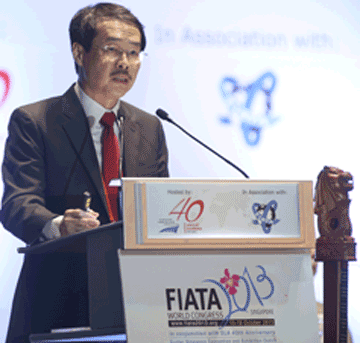 Mr Tiang Guan, TAY Deputy Director-General,
Civil Aviation Authority of Singapore, delivered his talk, telling the
audience that the government of Singapore set a national annual target
of 2-3 percent productivity growth in all sectors.
Mr Tiang Guan, TAY Deputy Director-General,
Civil Aviation Authority of Singapore, delivered his talk, telling the
audience that the government of Singapore set a national annual target
of 2-3 percent productivity growth in all sectors.
Meanwhile, the air cargo industry continues
to face regional competition and cost pressures.
Thus the objective of e-freight@Singapore
had been to allow the air cargo industry to achieve the productivity gains
by raising the productivity and enhancing the competitiveness of the Singapore
Air Cargo Industry.
The program started in Jan 2010 as an industry/government
collaboration with a number of objectives, including:
1. Remove
paper from the airfreight process
2. Capture
customer data at source and re-use across the supply chain
3. Ensure
interoperability of systems to encourage widespread adoption nationally
4. Future
proof the design on the national e-freight program
The findings of an initial study into the
Singapore air cargo sector were as follows:
1. Manual
processes were prevalent
2. 40 percent
of the data continued to be re-entered across the supply chain
3. Shippers
and Forwarders will be the beneficiaries, with shippers being the main
beneficiaries.
The study concluded that the total estimated
annual savings for the Singapore Air Cargo industry would be around 20
million SGD, achieved mainly though a saving of 1.7 million in man hours.
Key to the program’s success had been
the development of a single set of national data standards, based on international
standards, enabling solution providers and stakeholders to work to a single
set of data specifications.
This enabled complete compatibility and
inter-operability between systems, allowing data to be exchanged and re-used.
Some of the challenges include the inability
to persuade SMEs to change, sometimes due to lack of resources and expertise.
Many companies are still taking a ‘wait
and see’ approach.
The next steps for e-freight@Singapore are
as follows:
Nationally:
1. Increase
adoption by focusing on shippers
2. Re-engineer
the air freight process
Internationally:
1. Extend
e-freight beyond Singapore
2. Collaborate
with like-minded e-freight Champions
“No doubt the Singapore government
are firmly behind this project and this really helps to push things forward,”
Patrick Murray notes.
“That being said, it would have been
interesting to see how successful the program in Singapore has been to
date.
“Targets and penetration figures always
help the cause.
“No surprise that SMEs lack the resources
or the expertise to engage in e-freight.
“We have tried to address this by
developing a simple set of easy-to-follow instructions, which we shared
at the conference, and we will continue to push this. Engaging the shippers
also presents challenges.
“At CALOGI we have developed a module
for shippers that allows for them to trade electronically with their forwarders
to offset the cost of any software development.
“We have had some success in signing
up shippers, but we still have some way to go,” Patrick concluded.
Geoffrey/Flossie
|




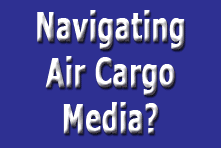

 As
our industry continues to talk about innovation, Dr. Wolfgang Baier, Group
Chief Executive Officer, Singapore Post Limited, shared some innovative
insights during his session presentation, ‘Internationalization
Strategies from Singapore Post's Perspective’.
As
our industry continues to talk about innovation, Dr. Wolfgang Baier, Group
Chief Executive Officer, Singapore Post Limited, shared some innovative
insights during his session presentation, ‘Internationalization
Strategies from Singapore Post's Perspective’. Mr.
Teck Leong LIM, Deputy Director-General (Compliance and Facilitation)
Singapore Customs shared his thoughts when presenting ‘AEO Programs
and MRAs (Mutual Recognition Assignments): International Developments
and Singapore's Perspective.’
Mr.
Teck Leong LIM, Deputy Director-General (Compliance and Facilitation)
Singapore Customs shared his thoughts when presenting ‘AEO Programs
and MRAs (Mutual Recognition Assignments): International Developments
and Singapore's Perspective.’  Prof. David Widdowson, Director and Chief Executive Officer - Centre for
Customs & Excise Studies, University of Canberra, Australia, shared
his thoughts during his presentation, ‘Impact of the Authorized
Economic Operator Concept and its Derivatives in the Context of Mutual
Recognition.’
Prof. David Widdowson, Director and Chief Executive Officer - Centre for
Customs & Excise Studies, University of Canberra, Australia, shared
his thoughts during his presentation, ‘Impact of the Authorized
Economic Operator Concept and its Derivatives in the Context of Mutual
Recognition.’ On day 2, Tony Tyler, Director-General & CEO of the International
Air Transportation Association, took the stand and talked about ‘Delivering
Solutions Together.’
On day 2, Tony Tyler, Director-General & CEO of the International
Air Transportation Association, took the stand and talked about ‘Delivering
Solutions Together.’ Mr Tiang Guan, TAY Deputy Director-General,
Civil Aviation Authority of Singapore, delivered his talk, telling the
audience that the government of Singapore set a national annual target
of 2-3 percent productivity growth in all sectors.
Mr Tiang Guan, TAY Deputy Director-General,
Civil Aviation Authority of Singapore, delivered his talk, telling the
audience that the government of Singapore set a national annual target
of 2-3 percent productivity growth in all sectors. 